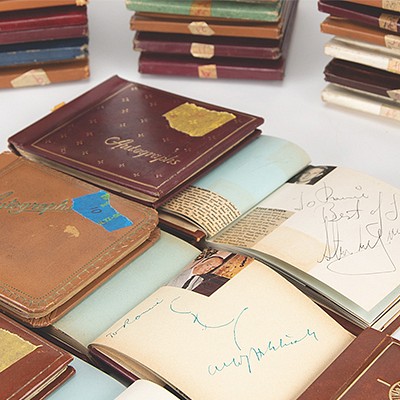Stan Laurel Early 'Keystone Trio' Document (1915)
Two ways to bid:
- Leave a max absentee bid and the platform will bid on your behalf up to your maximum bid during the live auction.
- Bid live during the auction and your bids will be submitted real-time to the auctioneer.
Bid Increments
| Price | Bid Increment |
|---|---|
| $0 | $5 |
| $50 | $10 |
| $200 | $25 |
| $500 | $50 |
About Auction
Aug 16, 2023
RR Auction's August Fine Autographs and Artifacts sale brings nearly 750 lots to the auction block, with a special focus on the collection of Dr. Charles Ronald Bauer—an in-person collector who focused on entertainment's elite. RR Auction support@rrauction.com
- Lot Description
Very early document related to 24-year-old performer Stan Jefferson, aka Stan Laurel, one page, 8.5 x 13.75, January 26, 1915. A memorandum of agreement between Feiber & Shea’s Theatrical Enterprises and the “Keystone Trio,” with performers “(Hurley-Stan-Wren),” for the group to perform at opera houses in New Brunswick and Bayonne, New Jersey, from February 1st until the 7th. Signed at the conclusion by Edgar Hurley, who adds “Hurley Stan & Wren.” Includes a 1917 artist contract for the “Keystone Trio,” which now no longer featured Laurel (signed by Hurley), and an original six-page typed draft script for a Keystone Trio skit called ‘The Nutty Burglars,’ a popular act performed by Laurel and the Hurleys when they worked the vaudeville circuit. On the advice of his agent, Gordon Bostock, Laurel cashed in on the wild success of Charlie Chaplin by having his Nutty Burglar character act more like 'The Tramp.' In overall very good to fine condition. Accompanied by 13 original glossy and matte-finish photographs of Laurel and Hardy at various stages of their career; several of the photos bear creases and/or small tears.
Stan Laurel was born Arthur Stanley Jefferson in Lancashire, England, in 1890. As a young comic, he received his big break when he joined Fred Karno's comedy troupe, where he was introduced to another young comic named Charlie Chaplin. Karno's troupe toured the United States in 1910 and then again in 1913. It was during that second tour that Stan Jefferson served as Chaplin's understudy. When Chaplin left the troupe mid-tour to go work for Mack Sennett in Hollywood, Karno eventually disbanded the company and returned to England. Jefferson, undaunted, formed a three-person comedy troupe with two other now out-of-work actors in the troupe, Edgar Hurley and his wife, Wren. Calling themselves "Hurley, Stan, and Wren" at first, and then later "The Keystone Trio," the group was a hit and ultimately played the Orpheum circuit, vaudeville's premier stage circuit. In 1916 The Keystone Trio broke up and Stan began touring with a new partner, Charlotte Mae Cuthbert. It was Cuthbert who suggested Stan change his surname to Laurel, which he did, and the two were known as Stan and Mae Laurel. Over the next few years, Laurel made the transition from stage to screen, but it wasn't until 1927 that he first teamed with Oliver Hardy to form the comedy duo known as Laurel and Hardy. - Shipping Info
-
Bidder is liable for shipping and handling and providing accurate information as to shipping or delivery locations and arranging for such. RR Auction is unable to combine purchases from other auctions or affiliates into one package for shipping purposes. Lots won will be shipped in a commercially reasonable time after payment in good funds for the merchandise and the shipping fees are received or credit extended, except when third-party shipment occurs. Bidder agrees that service and handling charges related to shipping items which are not pre-paid may be charged to a credit card on file with RR Auction. Successful international Bidders shall provide written shipping instructions, including specified Customs declarations, to RR Auction for any lots to be delivered outside of the United States. NOTE: Declaration value shall be the item’(s) hammer price and RR Auction shall use the correct harmonized code for the lot. Domestic Bidders on lots designated for third-party shipment must designate the common carrier, accept risk of loss, and prepay shipping costs.
-
- Buyer's Premium



 EUR
EUR CAD
CAD AUD
AUD GBP
GBP MXN
MXN HKD
HKD CNY
CNY MYR
MYR SEK
SEK SGD
SGD CHF
CHF THB
THB















